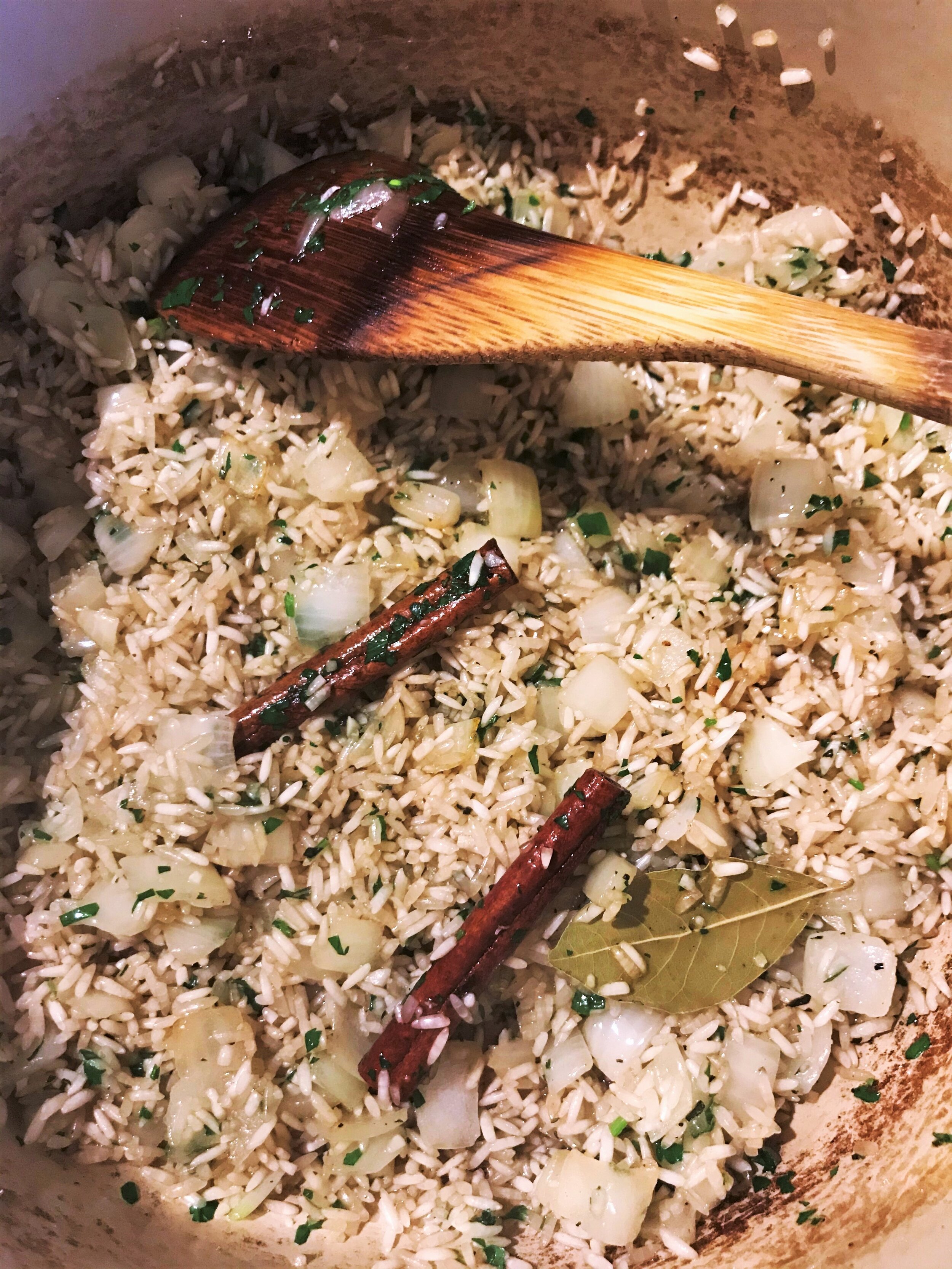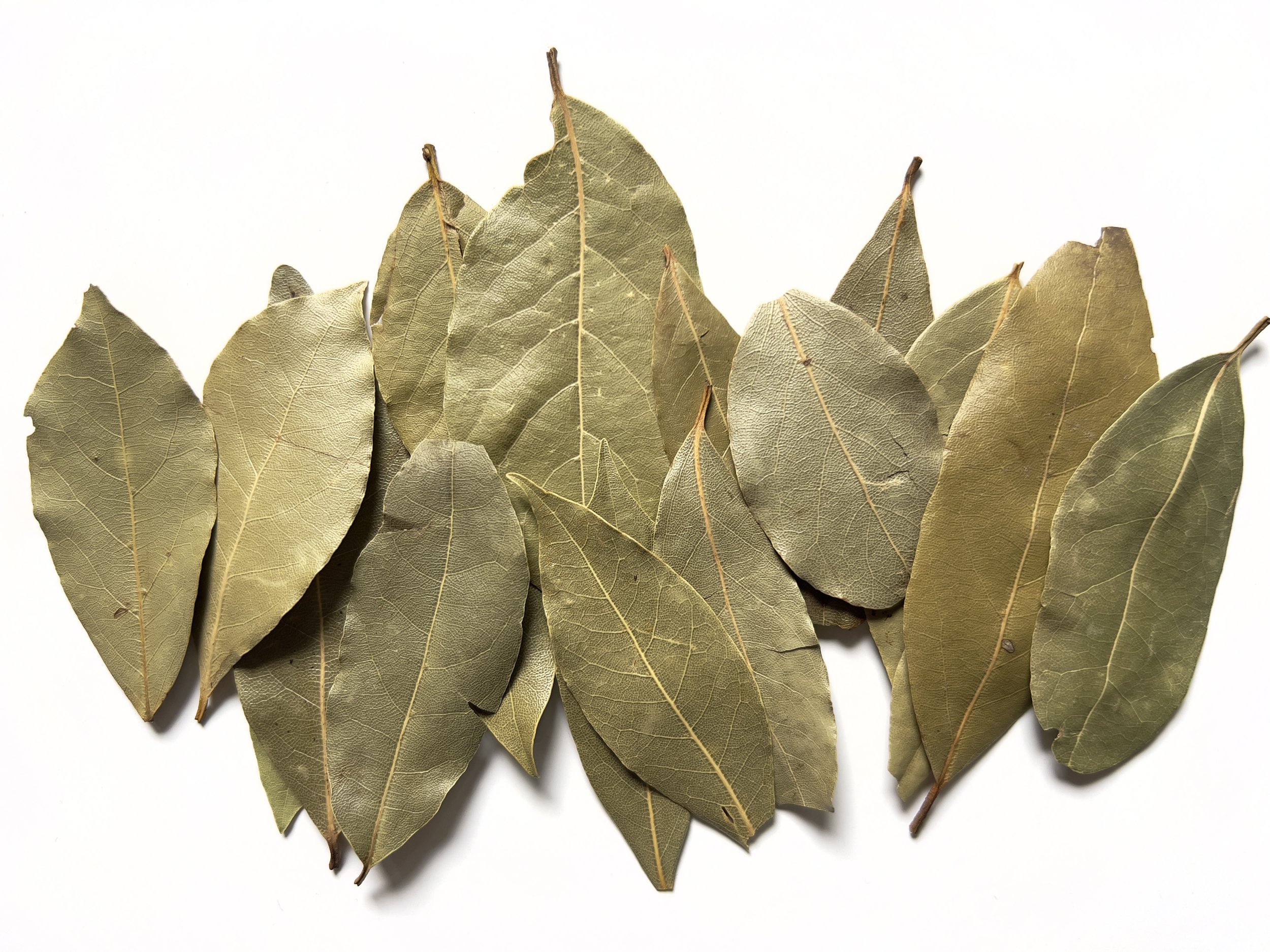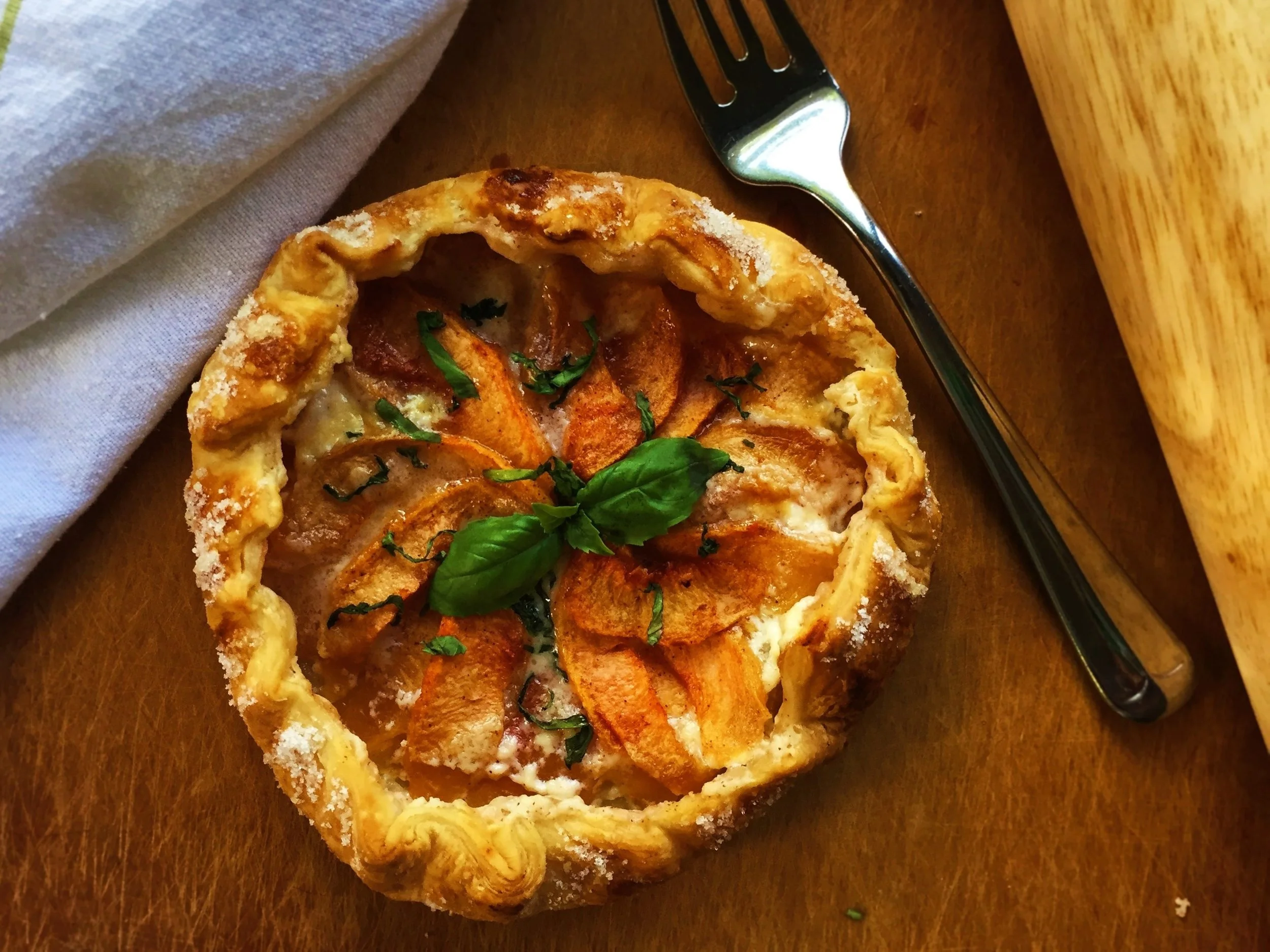Braised Chicken Thighs over Cinnamon-Rosemary Rice
Lynley Jones
Chicken thighs browned then poached with long-grain rice perfumed with cinnamon sticks, garlic and fresh rosemary. Check out the Notes section at the bottom for detailed tips for success, as well as serving suggestions for leftovers.
Serves 4-6
Ingredients
Braised chicken thighs over cinnamon-rosemary rice, ready to be served in the Adventure Kitchen.
6 chicken thighs (bone in, skin on)
Coarse salt (see notes)
Ground black pepper
1 ½ cups long grain white rice (see notes)
2 ½ cups chicken stock or broth (see notes)
3 Tablespoons olive oil
1 cup diced yellow onions
2 fat garlic cloves, minced
2 cassia cinnamon sticks, about 3 inches each
2 Tablespoons minced parsley
1 teaspoon minced fresh rosemary, plus more for garnish
1 bay leaf
½ cup dry white wine or dry French vermouth
¾ cup canned crushed tomatoes
Juice from half a lemon (about 2 Tablespoons)
Instructions
Prep the ingredients
1. Season chicken thighs all over with 1 teaspoon of coarse salt (use half this much if using table salt) and several grinds of black peppercorns (or a half-teaspoon of ground black pepper). Rest the chicken on a plate while you work on the next step (about 30 minutes or more is ideal).
2. Rinse the rice in several changes of cold water until the water is fairly clear, then set aside to drain. Separately, measure the broth into a small saucepan and stir in 1 ½ teaspoons coarse salt if the broth is unsalted, or ¾ teaspoon if it’s salted (again, use half these amounts if using table salt). Warm the broth, partially covered, until piping hot; then keep it covered until ready to use.
Brown the chicken
3. Set a heavy pot with a firm-fitting lid (such as a Dutch oven) on the stove over high heat. Add the oil, then brown the chicken pieces, skin-side down, in batches to brown well. Adjust the heat as needed to prevent the oil from smoking or burning. When the skin is richly browned, briefly turn the pieces to brown any other flaps of skin and cook the flesh side until it’s opaque (about 1-2 minutes more per thigh). Remove each batch to rest on a plate as you brown the next batch.
Start the rice and put all it together
4. When you remove the last piece of chicken, lower the heat to medium and add the onions and rice. Toss until the onions are soft and the rice is opaque, about 3 minutes. Add the garlic, cinnamon sticks, half the parsley, the rosemary and the bay leaf, and toss until fragrant. Stir in the wine and simmer for about a half a minute, then add the tomatoes, giving it another brief stir to combine everything.
5. Raise the heat to high and add the hot broth along with 1 tablespoon of the lemon juice. Briefly stir to combine, then let it return to a simmer. Return the chicken thighs to the pot along with any accumulated liquid, nestling the chicken thighs skin-side up to rest on the other ingredients (they’ll be partially submerged in the liquid). Put the lid on and turn the heat to low.
6. Cook for 30-35 minutes until most of the liquid has been absorbed and the chicken is cooked through.
Finish and serve
7. Briefly remove the chicken pieces from the pot. Sprinkle the final tablespoon of parsley over the rice and fluff it with a fork (if you find the cinnamon sticks in the pot, pull them out to use as a garnish). Return the chicken to the pot and sprinkle more lemon juice over everything. Garnish with a few extra rosemary leaves and the cinnamon sticks, then serve.
Notes:
I originally created this recipe for my friend Danielle’s business, Illuminate Food. They deliver a locally sourced box of farm-to-table (and maker-to-table) food and ingredients right to your door once a week, along with a recipe from a local chef that so you can cook with what’s in the box. (If you happen to live in the northern/central New Jersey area you should totally check them out!) Danielle asked me to contribute cinnamon sticks for a recent box, along with the guest chef recipe to use them in. We decided it should be something savory, and we also wanted to incorporate First Field’s delicious crushed Jersey tomatoes. So - voila! - this is the recipe that emerged.
The combination of cassia cinnamon with crushed tomatoes, garlic and herbs is really nice in this. Cinnamon is one of those ingredients that’s relegated to sweets and desserts in the US, but used in lots of other ways around the world. When I was working on this recipe, I was reminded of this other one originally brainstormed by my friend Nicholas, who was one of the kids in my cooking classes. If you don’t currently have cinnamon sticks on hand, you should definitely get some because they last for a long time, and once you have them you’ll find lots of things to use them in. (Scroll to the bottom for ideas to get you started.)
This recipe is one of those dishes (like arroz con pollo) where the chicken and rice cook together. The chicken flavors the rice as the aromatics in the rice flavor the chicken. They’re a team! Like Holmes and Watson. Or maybe more like Captain and Tennille. They make beautiful music. Love will keep them together.
But in any partnership, things can get a little tricky, and this is definitely the case with chicken and rice. Rice is a bit of a prima donna. It needs everything to be just so, or it may not perform well. Too much liquid and you have soup. Too little, and it’s undercooked. Stir it too much and you get a lot of starch. Peek too soon and things go south. Wait too long and everything gets mushy.
But when everything goes just right, the harmonies are delightful and the possibilities are endless.
So here are a few tips to help make sure everything goes beautifully when you make this:
Use a heavy pot. If you have a Dutch oven, that’s perfect! If not, use your heaviest pot with a tight-fitting lid. You want a pot that will retain heat and distribute it evenly.
Use long-grain rice. The shorter the grains, the more tendency to stickiness, so longer grains are better for this. Also, Basmati tends to cooperate a bit more than Jasmine, so if you have a choice go with Basmati. (When I made this I only had Jasmine, but if you’re new to cooking with rice, Basmati will be a bit more forgiving.)
Rinse the rice. Don’t skip this step. Rinsing washes away a lot of the starchiness, so your rice won’t be as sticky. The easiest way to do this is to put the rice in a large bowl and fill it with cold water. Swish it around in the bowl with your hand, then pour the water out (leaving the rice behind). Do this 2-4 times, depending on how starchy your rice is. The first time you fill the bowl with water, it will be quite cloudy, so much so that you might not be able to see the rice in the bottom of the bowl (using a glass or stainless steel bowl helps with the visual cues). With each successive rinse, the rice becomes more clearly visible in the bottom of the bowl. When you’re finished rinsing, you can leave the rice in a fine mesh strainer set over a bowl to drain until you’re ready for it. (Or just pour as much water out as possible.) Don’t leave the rice to soak in the water, or it will change the cooking time.
Heat the broth, but don’t let it evaporate! The timing of the recipe is based on the broth being hot when you add it, but if some of the liquid has evaporated you won’t have quite enough to cook the rice well. So here’s what I do: in Step 2, put the cold broth in a saucepan and set it over high heat, partially covered (the lid is on but askew). When you start to smell it and/or see steam escaping, you’ll know it’s getting hot. Give it a stir, look for more steam and taste it to confirm. When it’s piping hot, turn the heat to low and cover it completely to keep it warm without boiling over. After you finish browning the chicken, double check to make sure the broth is still hot, and adjust the heat as needed so it will be ready when you are.
Fry the uncooked rice in hot oil. This is Step 4. You want the oil to be hot enough to fry the rice within about 3 minutes, but not hot enough to scorch it. Everyone’s stove is different, but here’s what I do: as soon as I remove the last piece of chicken I turn the heat to medium and add the onions and rice together. The room-temperature ingredients will help cool the pan further, so keep an eye on things. If the pan seems too cool, turn the heat back up a bit. You should hear sizzling throughout this whole step, and by the end of the 3 minutes all the rice grains should be coated in hot oil, and they should be opaque but not browned. (This step helps dissuade the individual grains of rice from sticking together later.)
Don’t stir too much after you add the liquid. I was a little nervous when I wrote this recipe, thinking of you stirring after each addition of wine, tomatoes and broth. If you stand at the stove, stirring and stirring, mesmerized by the sights and smells of this beautiful dish, you’ll end up with too much starchiness. So just give it a brief stir after each addition and leave it at that.
What does “low heat” even mean? This is one of those tricky things about recipe writing: Every. Stove. Is. DIFFERENT! And each burner on your stove is different! And different pots are different! (When I was first learning to cook rice way back in the day, I followed a recipe that said “lowest heat.” The lowest heat on my stove was apparently much lower than the lowest heat on the recipe writer’s stove, because my rice was never finished at the end.) So - if you have experience cooking rice. then use the heat you normally use to cook rice on your stove and you’ll be fine. If not, set the burner to low. If the ingredients are simmering when you cover the pot and turn the heat to low, a heavy pot such as a Dutch oven should retain the heat and cook the ingredients as described in the recipe.
Check after 30 minutes but probably not before. Bad things happen when you peek at rice too soon. After 30-35 minutes, the chicken should be fully cooked, so the main thing is to check the rice at this point. When you lift the lid there may be just a tiny bit of liquid still simmering around the chicken pieces. Start by removing one chicken thigh and fluffing and tasting the rice that was underneath it. If it seems done, then it’s done! You can remove the rest of the chicken pieces and confirm they are cooked through, then finish the dish as described in Step 7. If the rice isn’t done, then return the one thigh to the pot, cover and cook for 5-10 more minutes. If there is quite a bit of liquid, do the same and increase the heat a bit to help things finish up.
Salty notes: I use Diamond Crystal kosher salt for this, which is coarsely ground. If you’re using regular table salt, you’ll want to cut the volume roughly in half.
Working ahead: You could season the chicken earlier in the day and let it rest in the fridge until you’re ready to cook. Also, you can rinse the rice in the morning and leave it to drain during the day so it’s ready to go. If you do this, leave it draining in a fine mesh strainer, or spread it on a lined sheet pan to air dry. Once all the ingredients are prepped and you’re ready to start browning the chicken, the recipe takes about an hour.
Want it spicy? My husband thinks just about everything should have a little kick to it. If this sounds like you, you can add up to a tablespoon of Aleppo pepper along with the other aromatics when you’re frying the rice in Step 4. If you’re using supermarket crushed red pepper, try just add a teaspoon. A pinch or two of cayenne pepper would also work nicely.
Ideas for leftovers! I used the leftovers to make rice bowls: I shredded the leftover chicken and served it over the rice with sauteed kale on top (lacinato kale sauteed with onions, garlic and Aleppo pepper). You could sprinkle sliced scallions and/or toasted almonds on top, and an extra squeeze of lemon over each bowl is nice.
Spices and ingredients used in this dish:
Cassia is the familiar type of cinnamon we grew up with the in United States. Warm, sultry and comforting. Steep it in a hot drink, use it in oatmeal or dessert, or make something savory with it.
Pure, organic, Premium Hand Select Grade true bay laurel leaves (Laurus nobilis). No GMOs, not irradiated. Certified Organic by QAI. Harvested from the north coast of Turkey.
Fragrant and flavorful, our bay leaves have an earthy aroma that adds savory flavor to any dish. Use them in soups, stews, or any slow-simmering savory dish, where they will gradually steep into the dish as it cooks, contributing its herbal flavor. Or, grind it and sprinkle it over chicken, meat, potatoes or vegetables with some salt and pepper for an herby twist.
Each jar contains 7 grams (about twice as much as a grocery store jar!)
Organic and fair-trade. We get our flavorful organic peppercorns from India. They’re bright and aromatic, with a nicely balanced flavor. A great stealth ingredient to take your everyday cooking up a notch. 1/2 cup-sized jar.
No grinder? No problem. We can now freshly grind these for you! Just click here to add this service to your cart before checkout.














Nubby steel-cut oats spiked with cinnamon, drizzled with maple syrup, and topped with fruit and nuts of your choice.